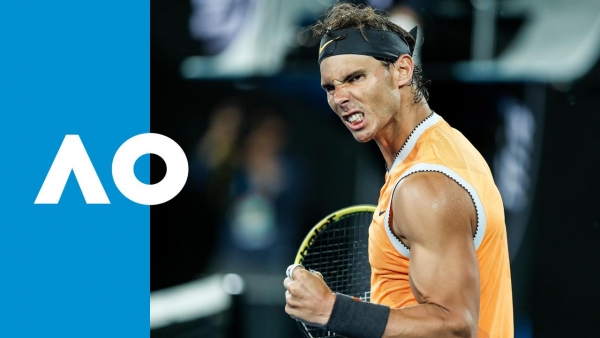Rafael Nadal admitted to John McEnroe on court on Tuesday that he felt the “possibilities were not very high” of him reaching the Australian Open semifinals before this fortnight started. And it’s easy to see why.
Heading into Melbourne, Nadal hadn’t played an official match since the US Open semis last September, and was coming off arthroscopic ankle surgery – which he underwent in November – and a right knee injury that forced him to retire against Juan Martin del Potro in the final four in New York.
Warming up for his season at an exhibition in Abu Dhabi, the Spaniard picked up a thigh strain that ruled him out of the Brisbane International.
His preparation for 2019 started later than usual, in mid-December, due to his physical problems, and he was unsure how well he would be able to perform at Melbourne Park.
The 17-time Grand Slam champion is no stranger to fighting back from injuries though, and his near-flawless run to the semifinals here – where he squares off with Greek sensation Stefanos Tsitsipas – is admirable, but not too surprising. He hasn’t lost a set through his opening five matches and has dropped serve just twice.
“That can happen but the possibilities were not very high,” Nadal told McEnroe in his on-court interview following his straight-sets victory over American Frances Tiafoe in the quarterfinals.
MORE: Rafa’s straight-sets roll runs to semis
“Just very happy. I feel lucky to be where I am after all the things that I went through to be able to keep competing at this level. That’s why I wake up every morning and I go on court or to the gym with a goal to be a better player.”
Tiafoe, who turned 21 the day of his fourth-round triumph over Grigor Dimitrov, was on the receiving end of a masterclass from Nadal in the last eight, and later explained what it’s like taking on the Mallorcan beast.
“I knew what he was going to bring to the table. I knew he was going to bring crazy intensity, I knew the ball was going to be jumping. I knew if he got hold of a forehand, it was going to be barbecued chicken. But point in, point out, I've never seen someone so locked in. I think that's what I take from him,” said Tiafoe.
Since he was forced to end his season early last year, Nadal took the opportunity to tinker with his serve, and the changes he made are already paying dividends.
The world No. 2 has been more aggressive than usual so far this event, playing excellent first-strike tennis, and utilising his new service motion to great effect.
He has landed 70 per cent of his first serves in, and has won 80 per cent of the points behind it. The 32-year-old has been successful in 97 per cent of his service games, and broken his opponents’ serve on 25 occasions.
Nadal is averaging 33.8 winners per match and has ventured to the net 65 times, winning 71 per cent of these approaches.
He has been incredibly efficient during his matches, and has spent just 10 hours and 25 minutes in total on his way to the semis. In comparison, his journey to the last four here in 2017 saw him spend 14 hours and three minutes on court over his first five matches.
“He comes up with shots we usually see [Roger] Federer come up with. I think he’s hitting the ball as well as I have seen him. Hitting the serve harder and again can improvise with the best of them. He’s looking pretty unbeatable,” said the legendary Martina Navratilova on Tennis Channel.
Nadal’s more aggressive plan has seen him construct more points with shorter rallies. An Infosys stats analysis done by Craig O’Shannessy for the ATP website revealed that 71 per cent of the points Nadal has played this tournament are rallies of 0-4 shots. In 2017, when the Spaniard made the final against Federer in Melbourne, his percentage in that category was just 62 per cent. He has also cut down on his longer rallies, with his average this fortnight for 9-plus shot exchanges just 8 per cent, compared to 14 per cent at the Australian Open two years ago.
Serve adjustments and strategies aside, Nadal’s biggest strength remains his focus, tenacity and determination, just as Tiafoe noted.
His commitment is something many other players look up to, including WTA stars. Spanish 1994 Wimbledon champion Conchita Martinez, who has helped coach Karolina Pliskova into Thursday’s semifinals at Melbourne Park, says Nadal can be a source of inspiration for her Czech charge.
“Rafa Nadal could be the perfect role model,” Martinez told reporters at the Australian Open this week.
“She was talking earlier this week about how it was amazing to see Rafa up, like, 6-0 6-1 3-0, still playing the same way he did on the first point. He’s still working the point, not making silly mistakes; he keeps going the same way.”
He’ll need more of that when he faces a red-hot Tsitsipas on Thursday. Is a fifth Australian Open final on the cards for Nadal? We’ll find out soon.
